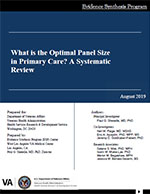
|
Prepared by: Recommended citation: |
Download PDF: Complete Report, Executive Summary, Report, Appendices
In 2009, the Veterans Health Administration Handbook 1101.02 established a baseline panel size of 1,200 patients for a full-time physician in a Patient Aligned Care Team (PACT). This number could be adjusted up or down based on availability of support staff, the number of examination rooms, and patient complexity. After adjustment for these factors, panels ranged from 1,000 to 1,400. Veterans Health Administration (VHA) Directive 1406 reaffirmed both the baseline panel numbers and adjustment parameters.
Determining the right or optimal panel size for a full-time physician and team is a complex undertaking, balancing the demands of the system (patient access to care, clinical effectiveness or quality, patient experience, and cost) with the needs of the provider team (physician/team satisfaction, adequate time for care, and avoidance of physician/team burnout).
The standard method for determining panel size has been a function of multiplying a provider's available slots each day by the number of days in clinic divided by the average number of visits each patient will make each year. But this method does not account for the tasks that occur outside of traditional face-to-face clinical visit, including patient communication (letter writing, telephone calls, emails, and form completion), test follow-up, panel management activities, and care coordination.
To help inform an expert panel that will consider issues about determining VA primary care panel size, we were asked to conduct a systematic review of the literature.
KQ1A. How should panel size be determined for a primary care provider?
KQ1B. What is the optimal size of a patient panel in primary care?
KQ1C. Is there evidence to suggest that MDs, NPs, and PAs should have different panel sizes?
KQ1D. Is there evidence from large health systems in terms of setting and maintaining panel sizes?
KQ2. Should primary care panel sizes be risk-adjusted for patient complexity? If yes, how should risk adjustment be accomplished?
Paige NM, Apaydin EA, Goldhaber-Fiebert JD, et al. What is the Optimal Primary Care Panel Size?: A Systematic Review. Annals of Internal Medicine. Published online January 15, 2020. DOI: 10.7326/M19-2491.
Systematic Review: What is the Optimal Panel Size in Primary Care? (Management eBrief)